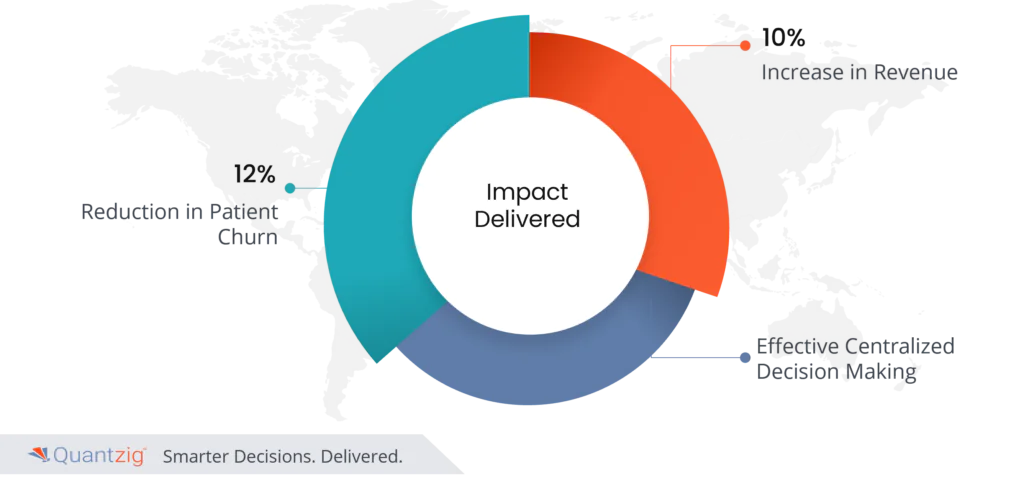
Table of Contents
Summary
Client: A leading global pharma company based out of the US
Challenges: The client faced the challenge of high employee churn rates across departments. However, there was a lack of insights into the potential reasons behind this attrition. The absence of a centralized system to analyze the employee journey made it difficult for the client’s leadership team to identify and address the root causes of churn. The lack of data integration and analysis hindered their ability to make informed decisions and develop effective retention strategies.
Solutions: Quantzig partnered with the client to address their employee churn challenge. The first step was to integrate employee data across systems, platforms, and locations into a dynamic database, creating a centralized repository of employee information. This data lake formed the foundation for building a customized employee journey analysis platform.
The platform captured and compared various metrics, such as performance indicators, grade pay changes, overall satisfaction, and more, across employee segments. The intuitive design of the platform facilitated easy navigation and comprehensive data visualization for the leadership team. By churn analysis, the platform provided directional insights, enabling the identification of potential triggers that led to churn within specific departments.
Impact Delivered
All of the above initiatives resulted in:
- 12% reduction in patient churn
- 10% increase in revenue
- Effective centralized decision making
Industry Overview
- The US pharmaceutical industry is a vital factor, encompassing companies involved in the research, development, manufacturing, and distribution of pharmaceutical products. With a strong emphasis on innovation, the industry invests heavily in research and development to bring new medications and therapies to market.
- Churn analysis holds significant importance in this industry as it helps companies identify factors contributing to customer churns, such as medication non-compliance, adverse side effects, or availability of alternative treatments. By analyzing churn patterns, pharmaceutical companies can develop targeted interventions to improve patient adherence, enhance drug safety, and refine marketing strategies.
About the Client
- A leading global pharma company based out of the US, despite its impressive revenue exceeding $2 billion, faced a significant challenge due to a recurring issue of high employee turnover across various departments. This detrimental churn rate had severe consequences, negatively impacting the company’s operations and overall performance.
- Recognizing the urgency to address the situation, the company aimed to identify the underlying reasons behind the employee churn. By pinpointing the root cause, they hoped to implement effective strategies and initiatives to enhance employee retention, ultimately leading to improved organizational stability and productivity.
Challenges
- The employee’s information about his journey with the organization, including performance metrics, responses from internal surveys, etc. was present in silos and there was no centralized way of looking at the employee journey for the HR department. The absence of a cohesive approach made it challenging to gain a holistic understanding of employees’ experiences, hindering the identification of patterns or potential triggers for churn. With this fragmented data landscape, the company struggled to track and monitor key milestones in an employee’s journey, making it challenging to assess engagement levels, job satisfaction, or any other factors that might contribute to attribution. As a result, the HR department faced significant hurdles in identifying specific areas of concern or potential improvements that could effectively address the high churn rate. Without a consolidated view of the employee journey, they could not make data-driven decisions or implement targeted retention strategies.
- There needed to be an analysis being done on employee attrition and the potential causes for the same thereby leaving no guidelines for the leadership team to make any strategic decisions to help prevent churn. Without identifying the root causes of churn, the company experienced a continuous cycle of talent loss without effective intervention. The lack of guidelines deprives leaders of a framework to make informed decisions, resulting in reactive measures rather than proactive solutions. Consequently, the organization struggled to create a supportive work environment, address systematic issues, and implement initiatives to retain valuable employees. Conducting churn analysis and developing guidelines is essential for the leadership team to take preemptive actions and foster a culture of employee engagement and retention.
Solutions
- Quantzig played a crucial role in integrating employee data from various sources, such as systems, platforms, and locations, into a centralized and dynamic database. By consolidating this data, the organization gained a holistic view of its workforce, enabling better analysis and decision-making. This integration allowed for a seamless flow of information across departments and eliminated data silos. The dynamic nature of the database ensured that employee information was regularly updated, providing real-time insights and accurate reporting. This comprehensive employee data integration empowered the organization to identify trends, patterns, and correlations, facilitating strategic workforce planning, talent management, and the implementation of targeted initiatives to enhance employee engagement and retention.
- Following the integration of employee data into a data lake, we leveraged this foundation to create a platform that captured and compared multiple metrics. This platform allowed us to analyze performance indicators, grade pay changes, overall satisfaction, and other relevant factors across different employee segments. By comparing the data between employees who churned out and those who stayed longer within the organization, we gained valuable insights into the characteristics and experiences of these groups. This comparative churn analysis shed light on potential drivers of attrition and identified factors that contribute to long-term employee retention. Armed with these insights, the organization could develop targeted strategies to address the specific needs of different employee segments and effectively mitigate churn.
- The intuitive platform design helped the leadership team identify the potential triggers that led to churn within employee segments thereby providing directional insights for the leadership team to make relevant strategic decisions. The user-friendly interface and comprehensive data visualization enabled the team to easily navigate and analyze the churn-related metrics and patterns. By examining these triggers, such as performance issues, compensation changes, or low job satisfaction, the leadership team gained directional insights into the underlying causes of attrition. Armed with this knowledge, they were able to make informed and relevant strategic decisions to address the identified issues and implement targeted initiatives aimed at improving employee retention. The platform’s intuitive design facilitated quick and effective decision-making, enhancing the organization’s ability to proactively manage churn.


